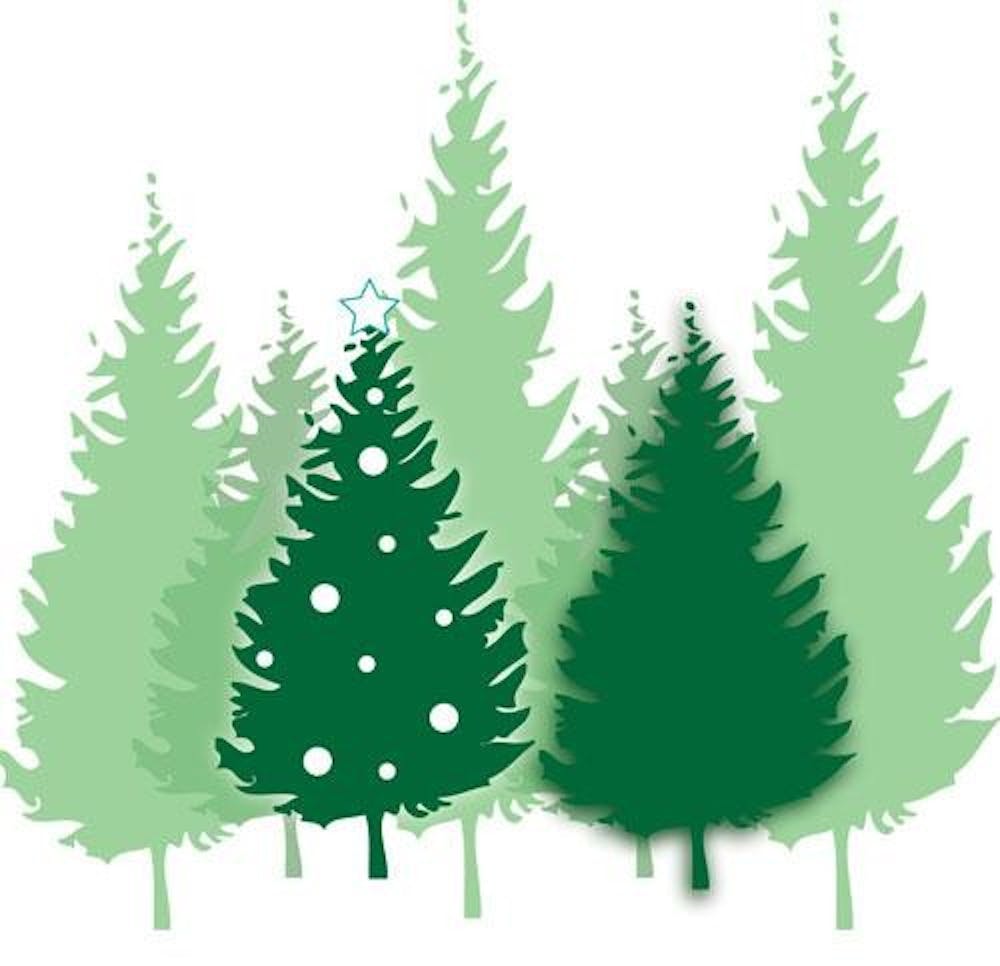
(ERIN KILLINGER | The Miami Student)
Like stockings, ornaments and hot chocolate, several articles analyzing the pros and cons of purchasing real or artificial Christmas trees reliably emerge annually around this time of year. Some points of contention between real and artificial trees lie with the pleasantries involved with one or the other, such as the presence or absence of allergens, the fresh pine smell or evergreen needles. But most articles discuss the environmental advantages and disadvantages of each.
As somebody that fractions paper towels for messes that don't require the whole piece, I always want everyone to make the most eco-friendly decision possible, but let's put this debate into perspective.
In November 2010, PE Americas published a Life Cycle Assessment (LCA) summary comparing the environmental impact of the most common type of artificial and real Christmas trees sold in the United States. The assessment was completed at the request of the American Christmas Tree Association (ACTA) and aimed to provide a cradle-to-grave analysis using a variety of measures more or less related to energy consumption and pollution.
The conclusion was that the greener option depends on multiple factors, but of course, the longer an artificial tree is used, the more environmentally favorable that route becomes. When kept for at least nine years, artificial trees seem to become the clear favorite. The best part of the LCA, however, was that in a brief, one-paragraph interjection amidst the lengthy article, the authors placed the Christmas tree dilemma in the sobering context in which it should be kept.
Americans on average cause the output of around 20 tons of CO2 per capita per year, while the life cycle of Christmas tree, real or fake, only amounts to several kilograms of CO2 emissions. The impact of buying a Christmas tree ultimately amounts to less than 0.1 percent of the average annual American carbon footprint.
According to ACTA, nearly 27 million Christmas trees (about 19 million real trees) were sold in 2010 in the United States alone. According to a Michigan State University forestry study, about 1,000 fir trees can be planted on an acre of land if they are five to six feet apart. This means about 19,000 acres (7,600 hectares) were needed to cultivate Christmas trees last year.
One acre is equivalent to 0.00156 square miles, so about 30 total square miles for farms were needed to provide the evergreen fix for real Christmas tree junkies in America in 2010. For comparison, Oxford is 6.75 square miles and Cincinnati is 79.6 square miles.
Meanwhile, according to the UN News Centre, the average, annual global forest loss in 1990-2000 and 2000-2010 was 13 million and 16 million hectares, respectively. Now, we are talking about a chunk of land approximately the size of Costa Rica. Nearly two million hectares of rainforest were cut down on average annually from 1986-2005 in the Legal Amazon region of Brazil, the world's second most beef-producing country.
In the deforested areas, 60-75 percent of the land was converted to pasture for meat production. Trying to make an environmentally conscious choice of which Christmas tree to adorn the living room is a noble battle, but there is a greater war at hand.
Of the 27 million Christmas trees sold in the U.S. last year, about eight million were artificial, according to the Clean Air Council. Two common environmental concerns raised about them are that they are made of polyvinyl chloride (PVC) and end up in landfills.
Enjoy what you're reading?
Signup for our newsletter
PVC is difficult to recycle, so most recycling centers don't mess with it. Eight million artificial trees with at most a couple of pounds of PVC for the needles equates to maybe 20 million or so pounds. Americans trash seven billion pounds of PVC annually. And remember, most artificial trees are going to be reused.
In addition to artificial pine needles, PVC is also used to make shoes, clothes, pipes, chairs, tubing, dishes, siding, flooring, bottles, bags, toys, TV's ... you get the point.
Christmas trees are iconic which makes them an easy target for debate in the media. Upwards of 90 percent of Americans celebrate Christmas, including most secular Americans, so that prevalence lends itself to a relatable situation.
But in the future when you encounter an article or conversation regarding the environmental effects of artificial and real Christmas trees, don't forget to keep it in perspective. Holiday conservation cheer should be spread throughout the year in more routine decisions. Responsible consumerism is the gift that keeps on giving for generations to come.




